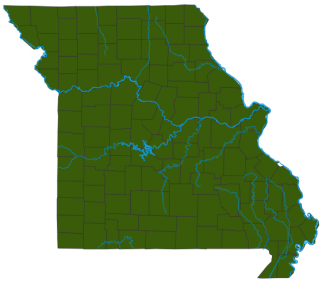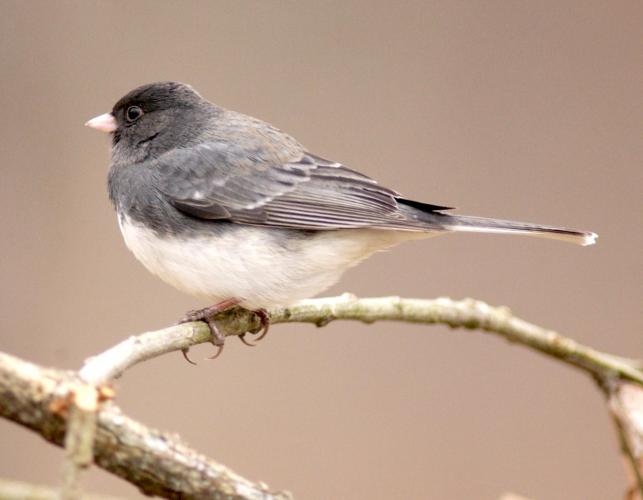
Dark-eyed junco male: unstreaked white belly; dark gray head; pink bill and legs; white outer tail feathers; no wing bars. Female: similar to male but paler. Juncos, which appear in two color forms, are abundant throughout Missouri during the winter. The most common color form is the slate-colored junco. It is light to dark gray all over except for its belly and the two to three outermost feathers on each side of the tail, which are white. The less common color form, Oregon junco, appears in the northern counties. The back is a red-brown and the sides are rusty to pink. The brown sharply contrasts with the black or dark gray of the head and chest, giving the appearance of a hood. Both color forms can be recognized by the sudden flash of contrasting white and dark tail feathers darting toward a bush.
Length: 6¼ inches (tip of bill to tip of tail).

Statewide.
Habitat and Conservation
Found in woods, openings in woods, fields, roadsides, and yards. Dark-eyed juncos are found nearly throughout North America, with 6 readily distinguished "forms" that were formerly considered separate species. In addition to the "slate-colored" and "Oregon" forms that are found in Missouri, elsewhere on the continent there are "white-winged," "pink-sided," "red-backed," and "gray-headed" forms.
Food
Commonly seen on or near the ground foraging for many kinds of seeds; frequently seen at bird feeders. Insects are an important part of the diet during breeding season when the juncos need extra protein for their growing young.
Status
Common winter resident; accidental summer visitor.
Life Cycle
Juncos arrive in our area at the beginning of winter and migrate north as spring arrives. They breed in forests in Canada and at high elevations and do not breed in Missouri. The female weaves the nest of grasses and pine needles in a depression on the ground or on a rock or other ledge. Clutches comprise 3-6 eggs, which are incubated for 12 or 13 days. Young fledge in 10-13 days. There can be up to 3 broods a year.
Human Connections
These common backyard birds are beloved by people all across America. Their arrival in early winter heralds the change of season, and watching their energetic feeding throughout the winter takes the edge off chilly days.
Ecosystem Connections
Ground-nesting birds, their eggs, and their young are vulnerable to a host of predators. Juncos help to limit the spread of the common weeds chickweed, lamb's quarters, and sorrel by eating their seeds. They help limit the populations of the insects they eat during breeding season.


Where to See Species
About 350 species of birds are likely to be seen in Missouri, though nearly 400 have been recorded within our borders. Most people know a bird when they see one — it has feathers, wings, and a bill. Birds are warm-blooded, and most species can fly. Many migrate hundreds or thousands of miles. Birds lay hard-shelled eggs (often in a nest), and the parents care for the young. Many communicate with songs and calls.






















